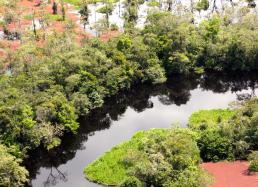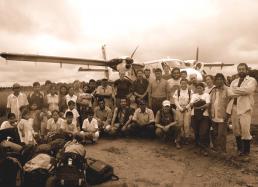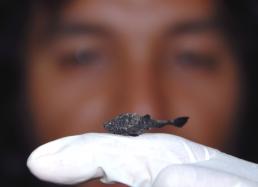About the Expedition
Field Museum scientists have a saying: “We cannot protect what we do not know.” That’s why, for more than a century, the Museum's scientific staff has made it their mission to seek out and document the diversity of life on Earth. The division of Environment, Conservation, and Culture (ECCo) was founded in 1995 specifically to translate museum science into lasting results for conservation and cultural understanding. In twelve years of work, the efforts of ECCo have led to the protection of 19 million acres of wilderness in the Amazon headwaters.
Rapid Inventories
To safeguard Amazonia, ECCo conducts Rapid Inventories—surveys designed to quickly identify and catalog the level of biological and cultural diversity found in each region. While ECCo's biologists and geologists sample the most remote, uninhabitated areas to document plant and animal species, the anthropologists visit nearby villages to record local peoples’ use of natural resources, their aspirations, and existing organizational strengths that can serve as entry points for future collaborations and capacity building. The team then brings together this biological and social information to create a practical road map for locally-supported conservation. By presenting their findings to policy makers at all levels, the team builds consensus among interested stakeholders and achieves a long-lasting conservation solution. The return on investment has been enormous: to date, ECCo’s track record is five acres protected per $1 invested in Rapid Inventories.
The 2007 Expedition
The Cuyabeno-Güeppí region of Amazonia consists of three poorly explored, partially protected areas (4.2 million acres) that meet along the borders of Ecuador, Peru, and Colombia. In October 2006, these three countries drafted an agreement to extend their protected areas and manage the region as an integrated conservation corridor. They invited Dr. Corine Vriesendorp and her ECCo team comprised of U.S., Peruvian, and Ecuadorian biologists and anthropologists to evaluate the region's diversity and recommend a plan of action. Dozens of species new to each country, several of which are also new to science, were documented during the expedition, indicating that these forests are among the most diverse on Earth! And yet, the team recorded evidence that this diversity is currently under seige by activities such as logging, oil concessions, fishing, and hunting, which endanger the abilities of plant, animal, and human communities to continue to protect their ways of life and resources.
To view the extraordinary biological and cultural diversity of Cuyabeno-Güeppí, and to learn more about the results of the team's Rapid Inventory, explore the stories in "About the Expedition," and be sure to check out Dr. Vriesendorp's photo galleries, videos, and blogs from the 2007 expedition.




